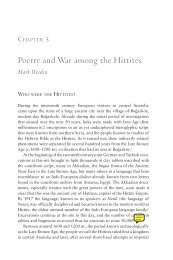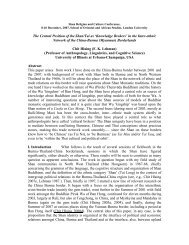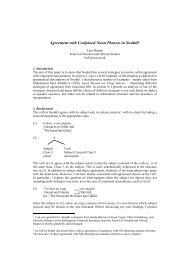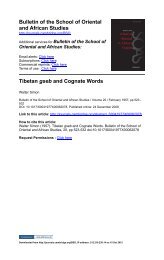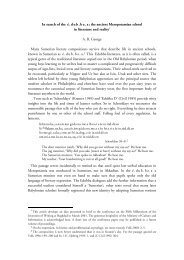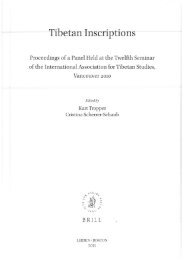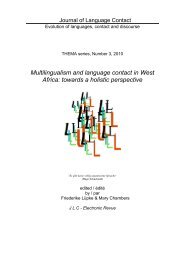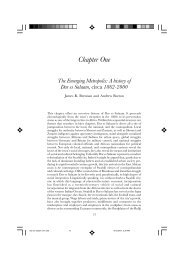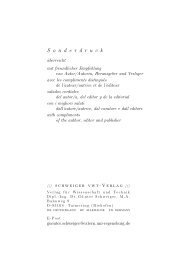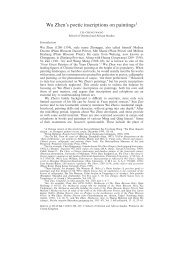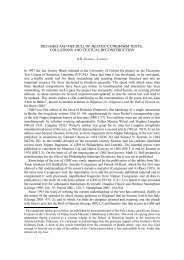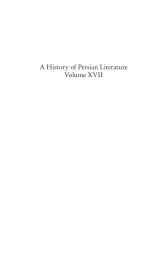Literarische Stoffe - The School of Oriental and African Studies
Literarische Stoffe - The School of Oriental and African Studies
Literarische Stoffe - The School of Oriental and African Studies
You also want an ePaper? Increase the reach of your titles
YUMPU automatically turns print PDFs into web optimized ePapers that Google loves.
108<br />
Almut Hintze<br />
dat.sg. Y 1.9 Y 7.11 Y 22.11<br />
hamaspaþma dii¡i Pt4<br />
hamaspaþma Ñii¡i Pt4<br />
hamaspaþmaiÑii¡i Mf1, J2 (corr. to<br />
°maidaii¡i ); J5<br />
hamaspaþmaidii¡i K5 K5<br />
…maspadma dii¡i J2<br />
hamaspaþmça Ñaii¡i J3<br />
hamaspaþamaiÑii¡i P11<br />
hamaspata. maiÑii¡i C1<br />
hamaspçþamaedii¡i H1<br />
hamaspçþamaiÑaii¡i J6<br />
hamaspaþamaidaii¡i O1<br />
hamaspati. maiÑii¡i P6<br />
acc.sg. Yt 13.49 Y 2.9 Vr 2.2 Y17.8 A 2.4<br />
hamaspaþma da m G G Pt4, K5 J2, J3 G Jp1 K4; Kh1 F2 H2 J9 Jm4 31<br />
hamaspaþma Ña m F1 E1 Pt1<br />
hamaspasma da m Mf3 K13 K38<br />
hamaspaþma Ñçm L18<br />
hamaspaþma d£m Mf1 Fl1<br />
hamaspaþamaiÑaem H1<br />
hamaspaþmaiÑaem J6<br />
hamaspaþmaeiÑçm J7<br />
hamaspaþma iÑaiia m K 7b<br />
It emerges from this survey that mai- is well attested in addition to mae- <strong>and</strong> ma -, <strong>and</strong> that<br />
at the end <strong>of</strong> the word the variant readings support both the stems -aiia- <strong>and</strong> -iia-. Moreover,<br />
confusion <strong>of</strong> -aiia- <strong>and</strong> -iia- is common elsewhere in the mss. 32 If the last term <strong>of</strong> the<br />
compound represents *-ma²d²a²a-, the spellings with -mai- are more correct. <strong>The</strong> -i- <strong>of</strong> maiis<br />
then an epenthetic vowel which developed after -ma- became part <strong>of</strong> the diphthong <strong>and</strong><br />
eventually resulted in the variant readings with -maÃ-. Such a development is parallel to that<br />
<strong>of</strong> OAv. paouruuiia- ‘Ÿrst’ (< Pr.Ir. *par³i²a-), in which, as emerges from its YAv. form<br />
paoiriia-, epenthetic -u- was interpreted as part <strong>of</strong> a diphthong. 33 In addition, the spelling -<br />
ma d- instead <strong>of</strong> -maid- could be due to the in uence <strong>of</strong> the acc.sg. ending -a m (< *-a²am)<br />
on the vocalism <strong>of</strong> the preceding syllable. A comparable phenomenon occurs in Vd 13.37 <strong>and</strong><br />
15.6, where ma Ðe is to be corrected to maiÐe, the loc.sg. <strong>of</strong> maÐa- ‘pit, hole, hollow’. 34<br />
where the word occurs in the gen. sg. <strong>The</strong> formula is in the dat. in Y 22.1 <strong>and</strong> Y 66.2–16 (= Y 7.5–19). In Y<br />
66 the mss. abbreviate.<br />
31 Geldner 1889–1896, II 179 gives these variant readings in Yt 13.49 no. 4.<br />
32 See Hintze 1994, 399 with fn. 149.<br />
33 On OAv. paouruuiia-, YAv. paoiriia- see HoÙmann & Forssman 1996, 52. Since anaptyctic u is older than<br />
anaptyctic i, the reinterpretation <strong>of</strong> -maid- as -ma d- must have happened at a later stage <strong>of</strong> the language<br />
development.<br />
34 Kellens 1974, 80f.; HoÙmann & Forssman 53. As convincingly argued by Kellens, the corruption is



